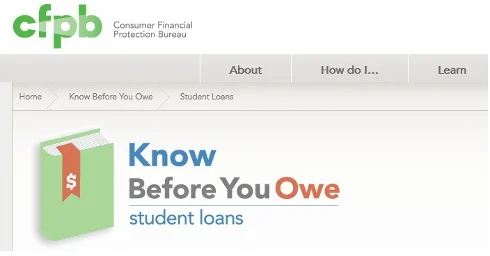The Consumer Financial Protection Bureau and Student Loans
- The CFPB (Consumer Financial Protection Board) is rolling out a prototype form for Student Loans in its Know before you Owe program.
- The CFPB offers advice about payment plans for student loans.
- Read the Bills.com articles about student loans and student debt relief.
CFPB Presents Grim Report on Student Loans
Student debt is growing and many Americans are asking themselves: How can I deal with my student debt? Increasing tuition and cost of living have driven the cost of college up.
Here is what the Consumer Financial Protection Bureau (CFPB) has to say about student debt, in its January 2012 report to Congress:
Student loans are a significant portion of household debt, second only to mortgages. Total outstanding student loan debt is estimated at $865 billion. And over the past decade, total student loan borrowing has increased 57% per full-timed enrolled student.
Congress created the CFPB to help ensure banks and related companies treat consumers fairly. The CFPB will help oversee the financial industry, which has been in turmoil since the 2008 housing meltdown. The CFPB aims to help the consumer receive clear forms and information from the banks and lenders. It also will be a place to lodge complaints.
The CFPB is focusing on three areas: Mortgage, Credit Card, and Student Loan.
This article will explain to you about the beginning steps taken by the CFPB in the area of Student Loan. The CFPB is focusing on the education process. It aims to provide the consumer good information to make the decision on how to take a loan, and how to deal with loan payments.
Quick Tip:
Bills.com offers many tools and resources about student loans. If you are having trouble paying your student loan then check out the Bills.com article about stopping garnishment on student loans.
Student Loans: Know Before you Owe
The Know Before you Owe slogan is one of the CFPB key areas of activity. The CFPB is working together with the Dept of Education to improve the information given to students and their ability to compare financial aid packages. The CFPB will also be seeking feedback from students and those involved in the educational industry.

The beginning point for any student who is interested in taking out a student loan is the FAFSA form, which is a long, detailed and complicated form. Once you fill out the application form, the school you applied to will inform you of the type of federal aid you are eligible to take. Then, if necessary, you can look into private student loans.
Quick Tip:
Read Bills.com article about getting a federal student loan and getting a private student loan.
The FAFSA form and the information provided to the student is often confusing, involving technical terms and special programs. The CFPB is seeking to create a prototype form that deals with taking a student loan.
The CFPB has set up a project to help design a form that will provide useful information for a student. The idea is to have the school provide details about the eligibility, future payments and general information about the college’s ranking in terms of graduation and default. For an example of the prototype form, see the CFPB Web site.
Student Loans and Payment Plans
Taking a loan is just the beginning of the process. Unlike many types of loans and credit (mortgage loans, credit cards, auto loans) student loans are not repaid immediately. That makes it more important for you to be aware of the amounts of money you will have to pay, and when you will need to begin the payments, usually at least by 6 months after completing school. Naturally, it is hard to know exactly what your income will be, but good research will make it easier for you to create realistic budgets.
The CFPB has provided a tool with some basic information about payment plans. For Federal loans, they refer you to the Dept of Education Web site. They also offer a very basic explanation of some of the payment terms and plans, such as forbearance, deferment, and Income-Based Plans for federal loans.
Summary: Student Loans - Avoiding Default
Student loans have become the second biggest type of debt in American society, after mortgage loans. The increasing cost of education has created a need for financing. The government has stepped in and increased its funding and the private student loan sector has decreased, but remains an option for many.
The CFPB has stepped in to help clarify the issues a consumer needs to know before shopping for a student loan. It has just begun to develop a student fact sheet and gather information regarding the fact sheet.
Bills.com has also taken the initiative to provide you with information about taking a student loan. Budgeting is a key step, both in deciding how much loans to take, and how to repay the loans. Follow the Dept. of Education’s steps to get the maximum federal aid, and then carefully consider the types of private student loans available.
Once out of school, consider carefully your options. Many Bills.com readers report they have trouble repaying their loans. Bills.com offers up-to-date information about student loan consolidation as well as advice about default on student loans.
